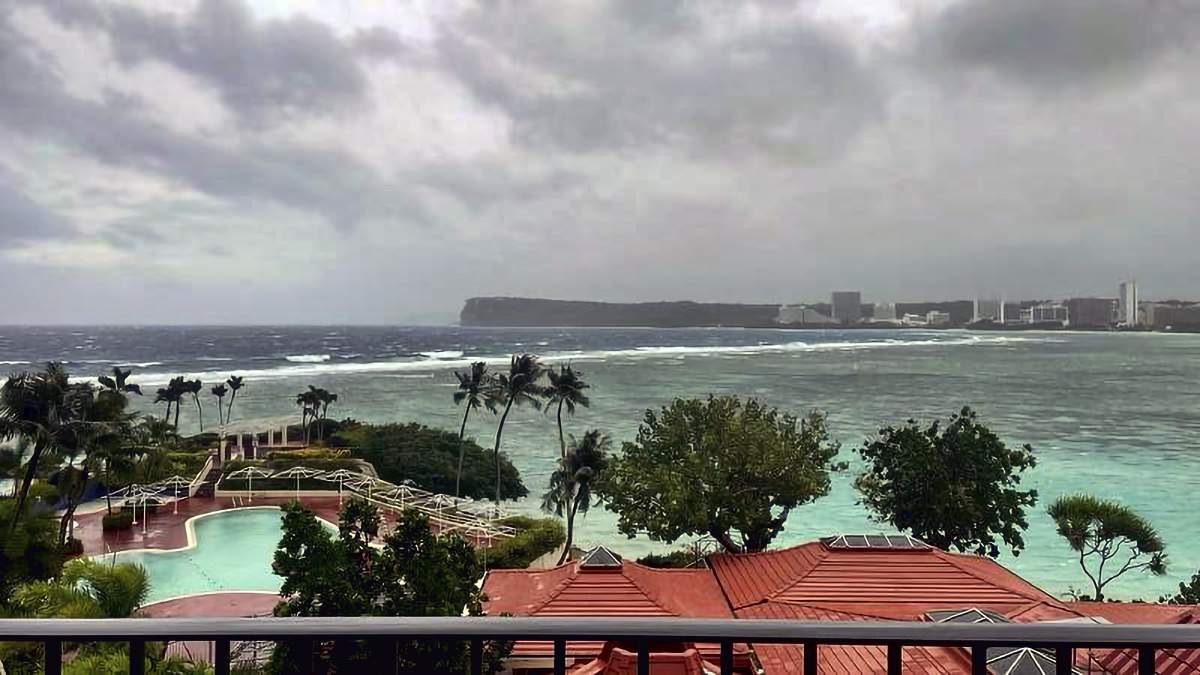Typhoon Mawar Closes in on Guam as Residents Shelter, Military Sends away Ships

This photo provided by the U.S. Coast Guard overlooking Noverlooking Tumon Bay in Guam, as Super Typhoon Mawar closes in on Tuesday, May 23, 2023.
11:07 JST, May 24, 2023
HAGATNA, Guam (AP) — Residents stockpiled supplies, battened down windows and abandoned wood and tin homes for emergency shelters as Guam was buffeted by rains and winds Wednesday from Typhoon Mawar, the strongest storm to approach the U.S. Pacific territory in decades.
The U.S. military sent away ships, President Joe Biden approved an emergency declaration and anyone not living in a concrete house was urged to seek safety elsewhere ahead of the typhoon, which was forecast to arrive as a Category 4 storm but could possibly strengthen to a Category 5. The last Category 5 to make a direct hit in Guam was Super Typhoon Karen in 1962.
Guam Gov. Lou Leon Guerrero said on social media that the emergency declaration will support the mobilization of resources into Guam, which is “especially crucial given our distance from the continental U.S.” Guerrero ordered residents of coastal, low-lying and flood-prone areas of the territory of over 150,000 people to evacuate to higher elevations.
Federal assistance will be needed to save lives and property and “mitigate the effects of this imminent catastrophe,” Guerrero said in a letter to the president requesting a “pre-landfall emergency” for Guam. Officials warned residents who aren’t in fully concrete structures — some homes on the far-flung island are made of wood and tin — to relocate.
Guam is a crucial hub for U.S. forces in the Pacific, and the Department of Defense controls about a third of the island. Rear Adm. Benjamin Nicholson, Joint Region Marianas commander, authorized the evacuation of defense personnel, dependents and employees in areas expected to be affected
All ships were moved out to sea as a standard precaution, according to the Navy, and any personnel remaining on the island were sheltering in place. About 6,800 U.S. service members are assigned to Guam, according to the Pentagon.
With rain from the storm’s outer bands already falling over the island as of late morning local time, the typhoon had maximum sustained winds of 140 mph (225 kph) with gusts peaking at 170 mph (274 kph), said Landon Aydlett, a meteorologist with the National Weather Service in Guam. Its center was about 75 miles (120 kilometers) southeast of the island and was moving to the north-northwest.
That was a slight downgrade from earlier when Mawar was reported to be a Category 4 “super typhoon,” meaning maximum sustained winds of 150 mph (241 kph) or greater. But it still posed extreme danger to life and property.
The weather service warned of a “triple threat” of winds, torrential rains and life-threatening storm surge and said it could hit Wednesday afternoon in southern Guam. The territory lies west of the International Date Line and is a day ahead of the U.S. mainland and Hawaii.
“This is going to be a rough afternoon for us across the island,” Aydlett said. “So watch out.”
Shool buses picked up residents at island community centers and transported them to 11 elementary schools outfitted as shelters. Civic workers in various villages warned residents to secure loose objects in their yards and seek shelter immediately. Some spread the word by megaphone, while others turned to social media. Power flickered off and on as the rain and wind intensified, and officials said nearly 900 people were in shelters.
If Guam doesn’t take a direct hit, it will be very close, said Patrick Doll, the lead weather service meteorologist in Guam. Mawar is a Malaysian word that means “rose,” he noted.
Guerrero urged residents in a YouTube message to remain calm and ordered the National Guard to help those in low-lying areas evacuate as people stocked up on water and generators.
“We are at the crosshairs of Typhoon Mawar,” she said. “Take action now, stay calm, stay informed and stay safe.”
A storm surge of 4 to 6 feet (1.2 to 2 meters) was expected, with dangerous surf of 20 to 30 feet (6 to 9 meters), the weather service said.
The storm was moving at 6 mph (10 kph) but had an eye 17 miles (27 kilometers) wide, meaning people at the typhoon’s center could see calm conditions for over three hours and conclude, far too soon, that the worst is over, Doll said. As the eye leaves, the winds could rise to 150 mph (241 kph) in minutes, so people should remain sheltered until the government gives the all-clear, he said.
“Folks may say, ‘Hey it’s over, we could go outside and start cleaning up,’” Doll said. “That is totally wrong.”
The weather service warned that “considerable damage” was expected, including non-reinforced concrete walls being blown down, fuel storage tanks rupturing, overturned cars and uprooted trees that could cut off residential areas for days or weeks.
Guam resident Albert Eliasson told KUAM News he was battening down and stocking up, including ensuring there was enough water to drink and flush toilets.
“Just making sure that we have things prepared, shutters on the windows that need it,” he said.
Another resident, Oshean Saralu, told KUAM he too was doing everything he could to prepare: “We usually pack everything up for most of our stuff inside our garage and just secure everything, especially the windows.”
Rota, an island in the U.S. Commonwealth of the Northern Mariana Islands, was also under a typhoon warning, Doll said. Tinian and Saipan, in the Northern Marianas, were under tropical storm warnings. Some people in those areas are still in temporary shelters or tents after Category 5 Super Typhoon Yutu in 2018, Doll noted.
Typhoon season runs from July 1 to Dec. 15 in the western North Pacific, according to the weather service.
“Mawar isn’t terribly unusual in location, but certainly in strength,” said University of Albany atmospheric science professor Kristen Corbosiero, a tropical cyclone expert. Usually one or two storms a year come within 50 miles of the island, she said.
The western Pacific is “a notorious breeding ground for intense tropical cyclones,’’ said Yale Climate Connections meteorologist Jeff Masters. “They’ve got a much bigger area to romp around in and more time to intensify.”
The National Oceanic and Atmospheric Administration has warned that in a warmer world, the number of Category 4 or stronger storms will increase by 10% — and Mawar “could well be a harbinger of the type of battering that the U.S. could expect to see,” Masters said.
Related Tags
"News Services" POPULAR ARTICLE
-

American Playwright Jeremy O. Harris Arrested in Japan on Alleged Drug Smuggling
-

Japan’s Nikkei Stock Average as JGB Yields, Yen Rise on Rate-Hike Bets
-

Japan’s Nikkei Stock Average Licks Wounds after Selloff Sparked by BOJ Hike Bets (UPDATE 1)
-

Japan’s Nikkei Stock Average Buoyed by Stable Yen; SoftBank’s Slide Caps Gains (UPDATE 1)
-

Japanese Bond Yields Zoom, Stocks Slide as Rate Hike Looms
JN ACCESS RANKING
-

Keidanren Chairman Yoshinobu Tsutsui Visits Kashiwazaki-Kariwa Nuclear Power Plant; Inspects New Emergency Safety System
-

Imports of Rare Earths from China Facing Delays, May Be Caused by Deterioration of Japan-China Relations
-

University of Tokyo Professor Discusses Japanese Economic Security in Interview Ahead of Forum
-

Japan Pulls out of Vietnam Nuclear Project, Complicating Hanoi’s Power Plans
-

Govt Aims to Expand NISA Program Lineup, Abolish Age Restriction























